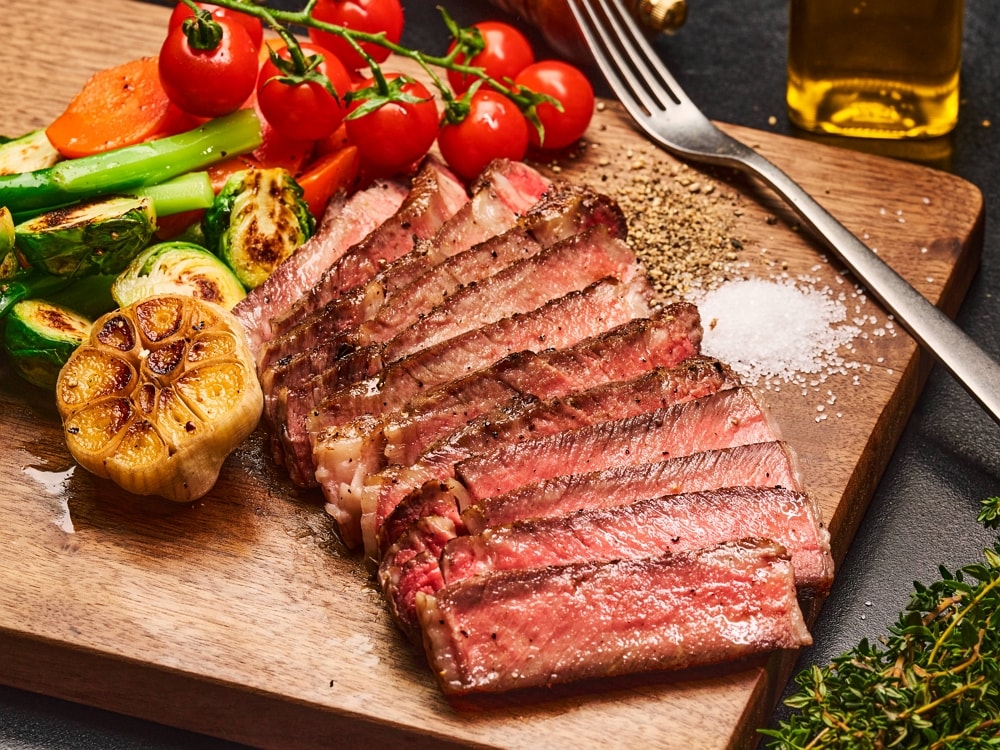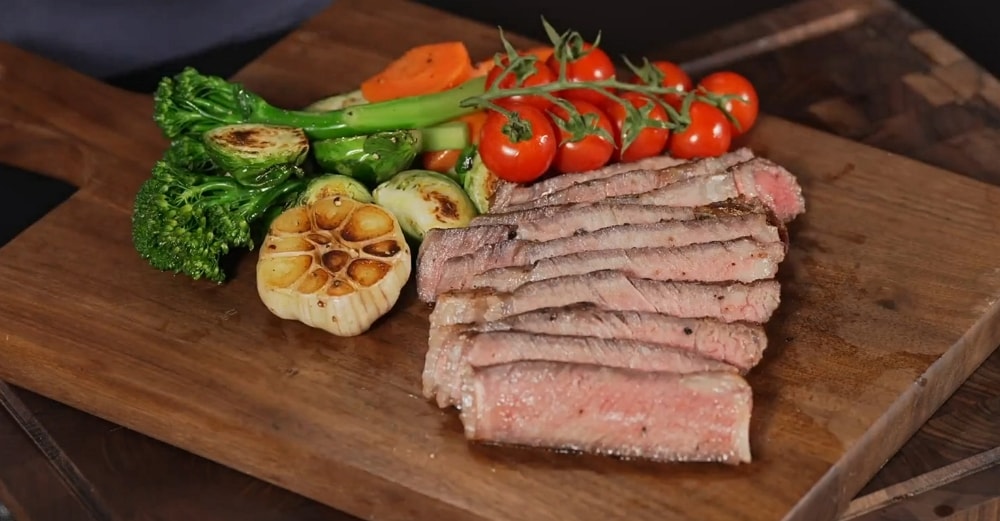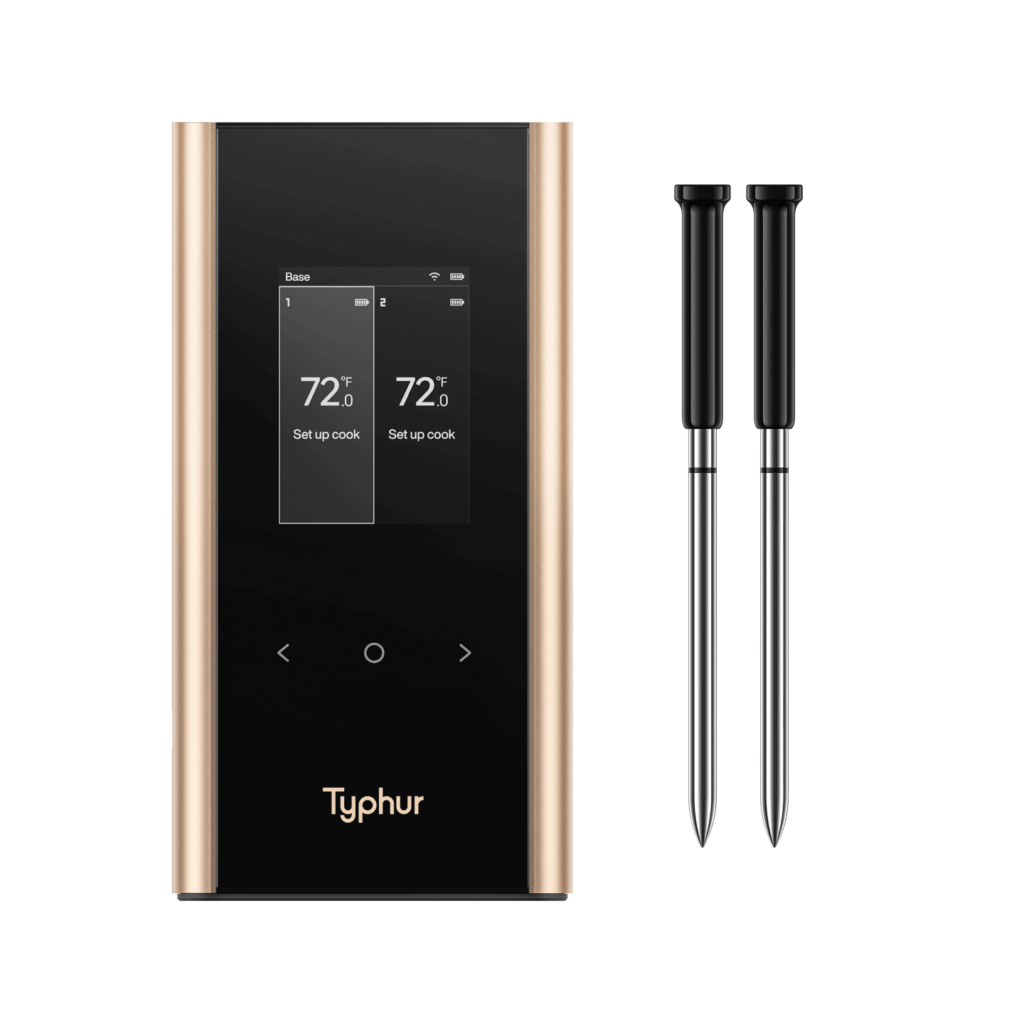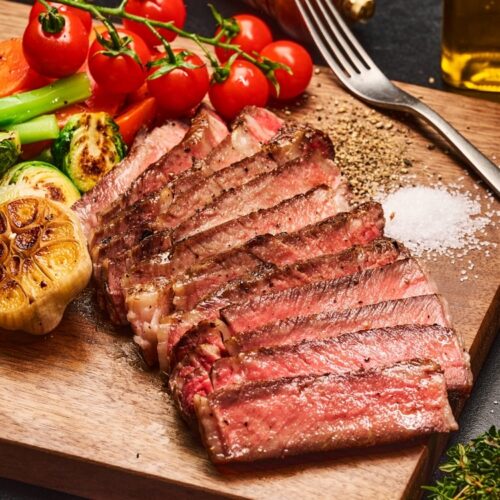For the ultimate medium-rare steak, boasting an even perfection from edge to edge and a tantalizingly crisp crust, look no further than the reverse seared steak.

Regarding steak cooking techniques, knowing what is right for you can be hard. Everybody likes their steak differently; working out the correct style is difficult. One choice that comes highly recommended today is the reverse sear steak.
To reverse sear, you go through a different cooking process than you normally would. If you’re exploring this method for the first time, this guide will break down everything you need to know about how to reverse sear a steak.
What is Reverse Sear?
Reverse searing is a cooking method often used for steaks, but applicable to other meats as well, that involves two main steps: slow cooking and then searing. Here’s how it works:
- Slow Cooking: First, the steak (or other meat) is cooked at a low temperature, either in a low oven, on a cooler part of a grill, or in a sous-vide bath. This slow cooking process allows the meat to cook evenly from edge to edge, achieving a uniform level of doneness throughout the meat without overcooking the exterior. The goal during this stage is to bring the steak up to a temperature that’s just below your desired level of doneness (Learn the steak temperature guide.).
- Searing: After the steak reaches the target temperature during the slow cook phase, it’s then seared at high heat for a short duration on each side. This final searing step creates a rich, flavorful, caramelized crust on the exterior of the steak through the Maillard reaction, while the interior remains tender and juicy at the desired level of doneness.
The reverse sear method is particularly beneficial for thicker cuts of steak (typically those that are 1.5 inches or thicker) because it gives the cook more control over the internal temperature, ensuring the steak is perfectly cooked inside with a delicious crust outside. It contrasts with the traditional method of searing first and then finishing the cooking at a lower temperature, which can often lead to a gradient of doneness from the edges to the center.

Why does reverse sear steak work?
A reverse-seared steak is cooked in a method that allows for a properly, thoroughly cooked interior without drying it. With a reverse sear steak, you will bring the temperature up slowly but surely in the oven or on the cool part of a grill before finishing it with a searing heat. This leads you with that ‘best of both worlds’ approach – nice cooked inside of the steak without making the crust of the steak overly crispy.
Is this the best way to cook steak?
As Kenji mentioned, the reverse sear is one of the best methods for cooking steak. While it may not be for everyone, those who choose to use the reverse sear method typically find it delivers excellent results. This technique is versatile, working well for both indoor and outdoor steak cooking, which is a nice bonus. It can even become your “party trick” when cooking for someone who prefers their steak medium-rare!
How to Reverse Sear a Steak
The good news about learning how to reverse sear a steak is that it is easy. Other steak cooking methods can feel like learning how to construct a rocket, but reverse sear methods are very easy. The steps that you need to take include the following:
Step 1. Start by seasoning your steak – we recommend a steak of at least 1.5” to 2” in thickness – and add the seasoning you want to use on your steak.
Step 2. Preheat your oven to a low temperature, around 248℉/120℃. Place the steak on a baking sheet. Determine your favorite doneness of the steak and remove your meat from the oven at the following temperatures: 105°F (41°C) for rare, 115°F (46°C) for medium-rare, 125°F (52°C) for medium, or 135°F (57°C) for medium-well.
The cooking time can vary dramatically depending on many factors, so it is crucial to monitor the internal temperature of the meat. The Typhur Sync Gold allows you to monitor the meat temperature on your phone, and notify you to remove your meat when it reaches the target temperature.

Long Range Wireless Meat Thermometer
Step 3. Once it reaches the above temperature by checking with a wireless meat thermometer, take the steak out and let it rest. Resting is so important. Allow that steak to rest for around 5 minutes, perhaps longer for thicker cuts.
Step 4. Now that your steak has rested place it into your skillet. Make sure the skillet is piping hot before you begin, though. What if you lack a skillet? You can use a standard grill –ensure you set the temperature to the maximum your grill will allow.
Step 5. Get the steak in there for around 45 to 60 seconds, sometimes a little longer, and flip the steak to repeat the trick on the other side.
By the way, just a quick note: you need a good-quality thermometer to make this work on your behalf. DO NOT try to guess the temperature: this is a surefire way to end up burning the steak and being unhappy with what you are left with at the end of the process.
Reverse Sear Steak Time Chart
The good thing with a reverse sear steak is that it often does not include most of the challenges or confusion that come with other steak cooking methods. To help you ensure you can go through the process quickly, we recommend using this reverse sear steak time chart and reverse sear steak temperature plan to have a good idea of times.
Please note, though, that these are all rough approximations. Depending on the kind of steak, the equipment you are using, and the conditions you are cooking in, these numbers could rise or fall by an important margin. So, again, ensure you are using a thermometer to keep an eye on this!
If you are putting a steak of around 1.5” in an oven heated to around 250°F (120°C), then you should focus on the following times:
| Steak Donesness | Remove From Heat Temperature | Target Temperature | Approximate Oven Cooking Time |
| Rare | 105°F (40°C) | 120°F (49°C) | 20-25 minutes |
| Medium-Rare | 115°F (46°C) | 130°F (54°C) | 25-30 minutes |
| Medium | 125°F (52°C) | 140°F (60°C) | 30-35 minutes |
| Medium-Well | 135°F (57°C) | 150°F (66°C) | 35-40 minutes |
Stick to the above times, and you should be well on target for cooking a steak that tastes great and fits in perfectly with the cooking style that you are looking for.
What Are the Disadvantages of Reverse Sear?
Now that you have a good idea of how long it takes to reverse-sear steak meat, you hopefully can see why this is so advantageous. However, we are not here to pretend that the reverse sear steak is perfect. The above should give you a good idea of how to reverse sear a steak and get the best flavor, but there are some considerations. Some of the most common disadvantages of reverse sear include:
- Reverse sear methods will not work with anything under 1.5” thick. This means that the meat cooks through too fast for an even cooking level throughout the meat.
- Another major disadvantage comes down to the sauce. A reverse sear steak method will not leave any ‘fond’ as all the brown bits will glue to the pan. This means no pan sauce, generally.
- This means that if you have a certain kind of sauce with your steak, then you will have to make that from scratch instead of relying on the pan to give you a start.
- However, it could be argued that a reverse sear method creates such a wonderful steak that you do not need a sauce. Still, that is down to personal interpretation.
- Lastly, cooking a reverse sear steak takes much longer than a normal steak. Compared to simply hurling that steak into a pan and flipping, this adds much time to cooking.
- If you are in a hurry, that timeframe is an important consideration. Especially if you cook steak without any sides, this can mean waiting longer than you are willing.
- Lastly, messing up with a reverse sear steak can be easy. This can mean having to start again, wasting high-quality meat that likely cost you a few dollars to buy.
Of course, some of these disadvantages are not a huge issue. But still, you should take them into account anyway.
Is Sous-Vide Steak Better Than Reverse-Seared Steak?
Good question! Reverse searing is, after all, a ‘cheap’ way to get a sous vide style. However, it would be fair to say that even with top-class sous vide setup, you will not get the same quality of searing with sous vide as you do with a reverse sear steak.
Sous vide steaks come out a bit damp/wet from the bag, meaning they often lack that same ability to get them to crisp up so well. Reverse sear steaks will always have a greater quality of ‘crust’ atop the steak. However, it would be fair to say that sous vide steaks are easier to get right compared to reverse-seared steaks. Reverse searing is, for many, a trial and error issue, which could mean wasting some pretty expensive meat without meaning it.
If you want a consistent finish to your steaks and do not want to risk wasting meat, go for a sous vide. If you are looking for a high-quality sous vide station, we recommend the Typhur Sous Vide Station. It is one of the best on the market and can make it easy to start cooking sous vide steaks without messing around or learning any methods.

FAQs about Reverse Seared Steak
Now that you can understand the benefits of reverse sear steak cooking, you must decide whether this is right. If you have any questions remaining, hopefully, the below answer for you in some detail.
The best cut of steak to use for reverse searing includes anything in the 1.5” to 2” size category. You should avoid using anything smaller than this. If 2” is too thick for you, some recommend using a single 2” steak for two people, slicing it in half to give each person around 1” each. Regarding steak style, ribeye, and filet mignon work best in our experience.
Yes, it would be best to flip your steak while cooking it. Allow the first side to brown for around 60 seconds in the searing solution you are using, and then flip it so the other side can get properly seared. You might even wish to sear the sides for that extra-special finish.
Yes, once the steak comes out of the oven, you should allow it to rest so the internal temperature can rise to the right level. This should be around 10 minutes of resting time, in our experience, though this can vary from cut to cut.

Reverse-Seared Steak Recipe
Video
Equipment
- Pan
- Tongs
- Paper Towels
- Spoon for basting
- Tray
Ingredients
For Roasting the Steak
- 300-500 gram ribeye Steak 2.5-3cm
- ½ tsp kosher salt
- 10 turns black pepper fresh cracked pepper
For Searing the Steak
- 1 sprig fresh thyme or rosemary
- 1 each garlic cloves whole skin on crushed
- 1 tbsp high-temperature oil: canola oil, grape seed oil, avocado oil 14g
- 1 tbsp unsalted butter for basting (optional)
Instructions
- Preheat the oven to 248℉/120℃.
- Dry out the exterior of the steak, and then generously season the steaks with kosher salt and freshly ground black pepper.300-500 gram ribeye Steak, ½ tsp kosher salt, 10 turns black pepper
- Place the steak on the oven tray, and insert your wireless meat thermometer to monitor the internal temperature of the steak. The probe should be inserted into the center of the thickest portion of the meat, ensuring that the safety notch is fully inserted into the meat.
- Now, place your steak in the oven. And then, by using the Typhur Sync wireless meat thermometer you can set the target temperature by selecting Beef > Steak > Rib-eye Steak in the parameters list on the Typhur App, and selecting your preferred doneness level: 125°F (52°C) for rare, 135°F (57°C) for medium-rare, 140°F (60°C) for medium, 150°F (66°C) for medium-well, or 160℉ (71℃) for well done. To begin the process, press the start button on your phone. You will be notified when it's ready to come out of the oven.
- Remove steak from Oven. Using a pair of oven mitts, carefully remove the tray with the steak and transfer it to a heat-resistant surface. Let the steak rest for at least 3 minutes. (Note: the internal temperature will continue to rise affected by Carryover Cooking). Pat the steak dry with a kitchen paper towel.
- When cooking is complete, carefully remove the probe and pat dry the steak.
- Sear that steak! Place a sauté pan over high heat and add high-temperature cooking oil (canola, grape seed, or avocado oil). When the oil begins to lightly smoke, carefully add the steak along with the garlic and herbs to the pan. Sear the steak on each side for approximately one minute. After flipping the steak, you can add unsalted butter for basting. This adds an extra depth of flavor and smells amazing!
- Slice against the grain and serve with your favorite side dishes, such as french fries, roasted carrots, or asparagus.
Nutrition PER SERVING
(Nutrition information is calculated automatically by Spoonacular API and should be considered an estimate.)




